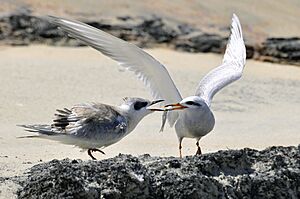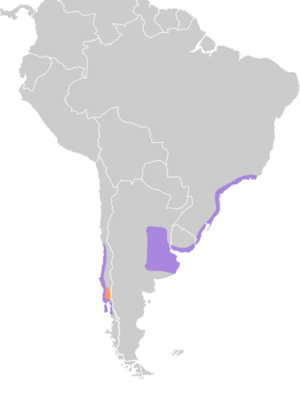Snowy-crowned tern facts for kids
Quick facts for kids Snowy-crowned tern |
|
|---|---|
 |
|
| An adult snowy-crowned tern feeding its chick in Brazil | |
| Conservation status | |
| Scientific classification | |
| Genus: |
Sterna
|
| Species: |
trudeaui
|
 |
|
The snowy-crowned tern (Sterna trudeaui) is a cool bird also known as Trudeau's tern. It's part of the tern family, which includes gulls and skimmers. This bird lives mainly in South America. You can find it in countries like Argentina, Brazil, Chile, and Uruguay. Sometimes, it might even visit Paraguay, Peru, or the Falkland Islands.
Contents
About This Bird
What's in a Name?
The snowy-crowned tern was first described by a famous American bird expert, John James Audubon, in 1838. He named the bird after his friend, Dr. James de Berty Trudeau. Dr. Trudeau had sent him a bird specimen, saying he found it in New Jersey.
How to Spot a Snowy-Crowned Tern
The snowy-crowned tern is a medium-sized bird. It is about 28 to 35 centimeters (11 to 14 inches) long. Its wings can spread out to about 76 to 78 centimeters (30 to 31 inches). It weighs around 146 to 160 grams (5 to 5.6 ounces).
This bird has a head that looks a bit blocky, a thick neck, long wings, and a tail that splits into two points, like a fork. Both male and female terns look the same.
- Adults in breeding season: They have a white head and neck. A black stripe goes through their eyes. Their upper body is light gray, and their lower body is grayish-white. Their wings are also light gray with shiny silver feathers at the tips. Their eyes are brown. Their bill (beak) is orange with a yellow tip and a black band in the middle. Their legs and feet are reddish-orange.
- Adults not in breeding season: They look similar but have a grayer stripe on their face. Their silver wing feathers are brighter. Their bill is black with a yellowish tip.
- Young birds: They have a black and white pattern on their back. They also have a black band near the end of their tail, a black bill, and dark legs.
Where Snowy-Crowned Terns Live
Their Home Range
Snowy-crowned terns breed in southeastern Brazil, Uruguay, and parts of Argentina and Chile. When they are not breeding, they travel along the Atlantic coast, sometimes as far north as Rio de Janeiro. On the Pacific coast, they can go as far north as Peru. They have also been seen in the far south, near the Straits of Magellan, and on the Falkland Islands.
Favorite Places to Live
These terns like to live near water. They can be found in coastal areas and wetlands, both with fresh water and salty water. However, they prefer freshwater places. They often build their nests in lagoons in areas like the Pampas and Patagonia. They also nest on islands within coastal lagoons.
How Snowy-Crowned Terns Behave
What They Eat
Snowy-crowned terns mostly eat fish. They also enjoy eating insects. They hunt for food in shallow water along the edges of wetlands, rivers, and lagoons. They also look for food over plowed fields. To catch fish, they dive headfirst into the water.
Reproduction and Family Life
Scientists are still learning a lot about how snowy-crowned terns raise their young. They seem to breed from October to December.
These birds nest in groups, called colonies. They often share their nesting areas with other birds, like brown-hooded gulls. They build a floating nest that looks like a platform in shallow water. This nest can float freely or be tied to plants growing in the water. Both the male and female terns work hard to protect their nest.
A female tern usually lays two to four eggs, but most often, she lays three. We don't know exactly how long it takes for the eggs to hatch or for the young birds to learn to fly. We also don't know all the details about how the parents care for their chicks.
How They Talk
The snowy-crowned tern has a special call. It sounds like a series of quick notes, "je-je-je-je." Sometimes, it makes a short, rough sound, "jeeer."
Status and Protection
The IUCN (International Union for Conservation of Nature) has listed the snowy-crowned tern as a species of "Least Concern." This means they are not currently in danger of disappearing. They have a fairly large area where they live.
There are fewer than 6,700 adult snowy-crowned terns, but their numbers seem to be stable. However, these birds only nest in large wetlands. This means that if their wetland homes are lost, especially if water is taken for farming, it could become a serious problem for them in the future.


